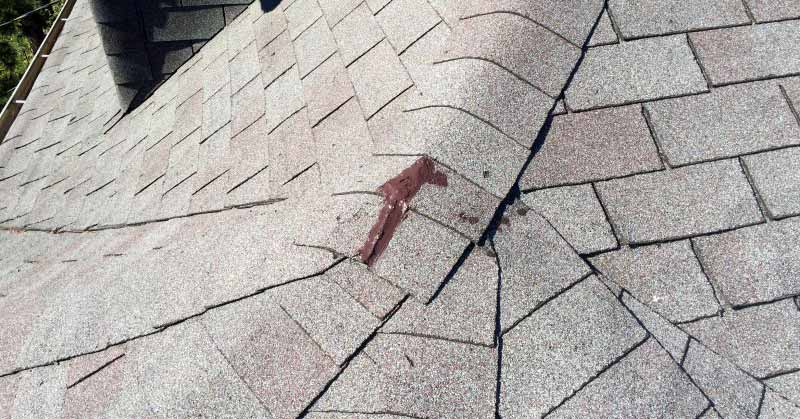How’s your roof looking this year?
Do you remember the last time you performed any sort of roof maintenance on your home?
It’s OK if don’t, because most people can’t, either.
In addition to cleaning out the storage room, patio, garage and closets, I’m also paying attention to maintaining the exterior of my home.
Including my roof.
Not the most fun in the world, but definitely something that needs to be done.
Many homeowners tend to overlook their roofs, however, and once the busy summer season starts, I know I won’t have the time (or the inclination) to be worrying about house maintenance.
For this reason, I created my “Roof Maintenance Checklist”: Get up there, do what I have to do and get down as quickly as possible!
Even if you had your roof done recently (and don’t foresee any problems), semi-annual roof maintenance checks really do need to be done.
Just to be sure.
The National Roofing Contractors Association (NRCA) recommends that a roof checkup be performed every spring and fall.
That way, you mitigate any damage or leaks early on.
You’ll also be able to book roofing contractors to repair your roof before the busy summer and fall seasons start.

Spring Roof Maintenance Checklist
The following is a roof maintenance checklist that every homeowner can complete on their own during spring cleanup:
Complete an interior inspection through your attic.
With a flashlight, get into your attic and see if your vents are still in place and check if there are any signs of wetness on the underside of the roof.
Is there water damage along the walls of the attic?
If there’s any dampness or wetness, that’s a sure sign of a leak happening.
While in the attic, see if there’s any light coming into the attic from the roof.
It sounds obvious, I’m sure, but this means that there’s a hole on your roof.
Check for mold.
Do you see any spores in the attic or ceiling space?
Can you smell mold or mildew anywhere?
If there’s any dampness or improper venting in a home, mold will eventually take root and it’s a very expensive fix once it’s spread to the drywall and ceilings.
Check your ceilings.
Walk around the second story, or the story below your roof structure and look at the ceiling closely: are there any drywall spots, or is the plaster tape pulling away—these are signs of moisture damage.
Assess your exterior eavestroughs.
From the ground, check to see if all your eavestroughs are firmly attached to the fascia.
If there’s a gap in between them, then they could potentially fall off.
During rain, check if the eavestroughs are overflowing.
Which could mean that your gutters or downspouts are plugged.
Water should be running freely and not overflowing at any point, this creates water damage on the roof over time and contributes to mold.
Assess your shingles/tabs.
It’s possible to see missing shingles or tabs if you’re standing at a distance from your home.
The south to southwest facing side of the roof will typically show the most damage and it will be the most deteriorated and problematic part of the roof.
That’s the side that should primarily be looked at in your home.
Do not attempt any roof maintenance – like fixing missing or loose shingles – yourself!
Without proper safety harnesses and equipment, it’s extremely dangerous and especially on high-pitch roofs.
This is when you call a roofer to fix any missing or loose shingles.
Check for algae staining.
Standing at a distance from your home, it’s also possible to see algae staining which looks like a black-green stain on your roof, usually around any overhanging trees.
Algae holds moisture and contributes to the breakdown of your roof, causing it to rot and deteriorate.
Trim your trees.
Make sure trees are trimmed away from your home to prevent damp or shaded areas to occur on your roof—this is actually how mold or algae starts growing.
Falling branches can damage your roof, so make sure you’re checking over your trees and not letting any branches touch your roof, as this causes roof damage or punctures if left unchecked.
Clean out your gutters.
Gutters play a large part in how water moves off your roof; if they are not clean, water will back up onto your roof and cause moisture damage to your home.
As well, if they are rusty and full of holes, water will seep straight down into your home’s foundations, resulting in wet or damp basements over time.
To clean out your gutters.
First use outdoor gloves and remove any leaves, twigs, seeds or other gunk that may have settled there over the winter months.
Don’t flush them with water to save yourself this step as you will end-up with a clogged downspout.
Only after the debris is cleaned out, then you can use a hose to flush out any remaining residue and clear out the downspouts.
NOTE:
Some homeowners are not comfortable up on a ladder, or have a steep roof.
If you’re not comfortable with heights, don’t attempt this step on your own.
Call a roofing contractor to help with your yearly roof maintenance and stay safe.
Now that you’ve used your roof maintenance checklist to assess your roof, you’re on your way to enjoying a stress-free spring and summer season.
Don’t forget to tune in for my fall roof maintenance checklist when you get to do it all over again to avoid any winter roof damage!
Again, if you do notice any loose or missing shingles or water damage in your home, it’s time to call a Kelowna roofing contractor you can trust to fix the problem.
